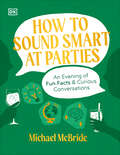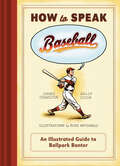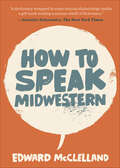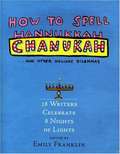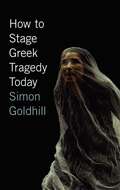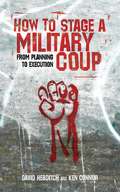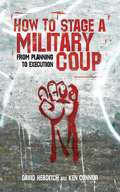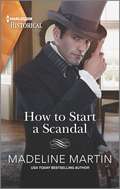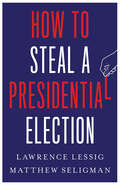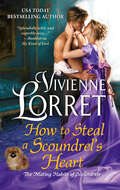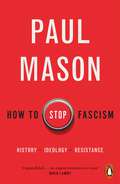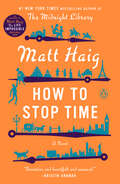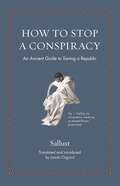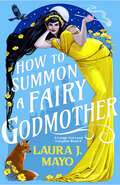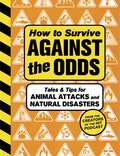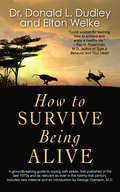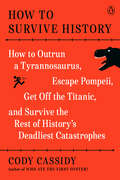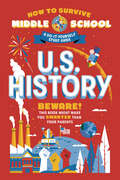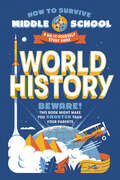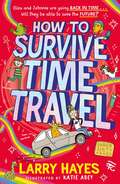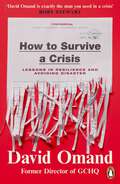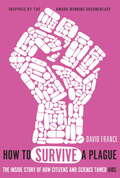- Table View
- List View
How to Solve the Da Vinci Code
by Richard ElwesCan you outrun a bullet? How do you build an electronic brain? Could you slow down time? How do you unleash chaos? From Plato's classification of regular polyhedra to making a million on the stock market, How to Solve the Da Vinci Code gives you everything you need to understand how numbers work, and the impact they have on our lives every day.
How to Sound Smart at Parties: An Evening of Fun Facts & Curious Conversations
by Michael McBrideWelcome to the most interesting dinner party you&’ve ever attended!Join seven friends for an evening of trivia, myth-busting, and camaraderie. You'll have a front row seat at the party, listening in to the early small talk—where light and fun ideas are discussed (&“Did you know astronauts have Velcro on the inside of their helmets to scratch their noses?&”)—to the end of the night, when conversations get deeper. (&“Did the popularization of drinking coffee lead to modern democracies?&”)Packed with over 150 fun facts spanning the topics of ancient civilizations, animal behavior, natural science, outer space, human accomplishments, pop culture, and more, How to Sound Smart at Parties ensures you&’ll always have something clever to contribute to the conversation.
How to Speak Baseball: An Illustrated Guide to Ballpark Banter
by Sally Cook James Charlton“An elegantly designed little book . . . capturing the colorful, frequently fanciful vocabulary that describes the world of baseball.” —The Litchfield County TimesThis handsome guide to the language of baseball decodes the amusing, clever phrases that pepper commentary about the sport. Packed with witty explanations of everything from “duster” and “rubber arm” to “up the elevator,” this ballpark lexicon plays on a nostalgic love for the national pastime while covering ground from baseball’s beginnings to today. This humorous mix of definitions and anecdotes is the perfect gift for both lifelong baseball fans and rookies “working up the ranks.”“If you happen to be watching or listening to a game, do you wonder what the announcer means by ‘the neighborhood play,’ ‘can of corn’ or ‘golden sombrero?’ How to Speak Baseball: An Illustrated Guide to Ballpark Banter, by James Charlton and Sally Cook, is an informative, entertaining read. The authors have compiled a list of obscure, old and newer baseball terms from ‘ace’ to ‘you can’t walk off the island.’” —Daily Pilot
How to Speak Midwestern
by Edward McClelland&“A long-overdue study of the middle-American vernacular, and how that vernacular informs our identity . . . A regionally specific Urban Dictionary.&” —Inside Hook The Pittsburgh toilet. Squeaky cheese. City chicken. Shampoo Banana. Chevy in the Hole. These are all phrases that are familiar to Midwesterners, but foreign to anyone living outside the region. Find out what they mean in How to Speak Midwestern. Edward McClelland will not only explain what Midwesterners say, but how and why they say it. He examines the causes of the Northern Cities Vowel Shift, one of the most significant changes in English pronunciation in a thousand years; explains why the accents in Fargo miss the nasality that&’s a hallmark of Minnesota speech; and reveals why Chicagoans talk more like people from Buffalo than their next-door neighbors in Wisconsin. For outsiders, McClelland will include helpful information such as &“How to Talk Through Your Nose,&” &“How to Mispronounce Foreign Place Names,&” and &“&‘Well, That&’s Different&’: How to Passive-Aggressively Criticize People, Places and Things.&” If you&’re from the Midwest, you&’ll have a better understanding of why you talk the way you do. If you&’re not, well, you&’ll know exactly what to say the next time someone ends a sentence with &“eh?&” &“How to Speak Midwestern is a fascinating read, whether you hail from WOWOland, the UP, Cereal City, or Baja Minnesota.&” —Chicagoist &“A dictionary wrapped in some serious dialectology inside a gift book trailing a serious whiff of Relevance.&” —The New York Times
How to Spell Chanukah: 18 Writers on 8 Nights of Lights
by Emily Franklin"What a holiday! No pestilence, no slavery, no locusts, no cattle disease or atonement. No synagogue, no guilt, no mortar, and no real lesson to be absorbed and passed down to my Jewish offspring. Thank God," writes Joshua Braff, one of eighteen Jewish writers who extol, excoriate, and expand our understanding of this most merry of Jewish holidays. These essays, by Adam Langer, Tova Mirvis, Steve Almond, Eric Orner, and others, range from the comedic to the snarky, the poignant to the poetic, and includes such topics as the jealousy experienced in December when the rest of America is celebrating Christmas (we never get to join in the reindeer games!); the problem parents have dampening their children's desire for more presents (call it Greedikah!); and the weight gain associated with eating 432 latkes in eight nights (dayenu, enough!). Whether your Chanukahs were spent singing "I have a Little Dreidel" or playing the "Maoz Tzur" on the piano, whether your family tradition included a Christmas tree or a Chanukah bush, whether the fights among your siblings over who would light the menorah candles rivaled the battles of the Maccabees, or even if you haven't a clue who the Maccabees were, this little book proves there are as many ways to celebrate Chanukah as there are ways to spell it.
How to Stage Greek Tragedy Today
by Simon GoldhillFrom the stages of Broadway and London to university campuses, Paris, and the bourgeoning theaters of Africa, Greek tragedy remains constantly in production. This global revival, in addition to delighting audiences, has highlighted both the promise and the pitfalls of staging ancient masterpieces in the modern age. Addressing the issues and challenges these performances pose, renowned classicist Simon Goldhill responds here to the growing demand for a comprehensive guide to staging Greek tragedy today. In crisp and spirited prose, Goldhill explains how Aeschylus, Euripides, and Sophocles conceived their works in performance and then summarizes everything we know about how their tragedies were actually staged. The heart of his book tackles the six major problems facing any company performing these works today: the staging space and concept of the play; the use of the chorus; the actor’s role in an unfamiliar style of performance; the place of politics in tragedy; the question of translation; and the treatment of gods, monsters, and other strange characters of the ancient world. Outlining exactly what makes each of these issues such a pressing difficulty for modern companies, Goldhill provides insightful solutions drawn from his nimble analyses of some of the best recent productions in the United States, Britain, and Continental Europe. One of the few experts on both Greek tragedy and contemporary performance, Goldhill uses his unique background and prodigious literary skill to illuminate brilliantly what makes tragedy at once so exciting and so tricky to get right. The result will inspire and enlighten all directors and performers—not to mention the growing audiences—of ancient Greek theater.
How to Stage a Military Coup: From Planning to Execution
by Ken Connor David HebditchFed up with taxes? Angered and disappointed by corrupt leaders? How to Stage a Military Coup lays down practical strategies that have proven themselves around the globe. David Hebditch and Ken Connor examine, with a critical eye, successful as well as failed coup attempts throughout the twentieth century with the aim of showing their readers just what it takes to swiftly and soundly overthrow a government. Exploring coups from Nigeria, to Cuba, to Iraq, and with true stories of SAS combat written by Ken Connor, the book gives an insightful glimpse into this violent and rarely-seen world of shifting power. How to Stage a Military Coup is a unique textbook for the armchair revolutionary, as well as a practical guide for the idealist with a soft spot for the sound of artillery fire. From evaluation of the political climate and investigation of potential allies, to recruiting and training personnel, to strategies for ensuring timely transfer of power, the book leaves no aspect of the coup d'état unexamined. The book also includes appendixes, notes, and a world map of coups d'état.
How to Stage a Military Coup: From Planning to Execution
by Ken ConnorFed up with taxes? Angered and disappointed by corrupt leaders? How to Stage a Military Coup lays down practical strategies that have proven themselves around the globe. David Hebditch and Ken Connor examine, with a critical eye, successful as well as failed coup attempts throughout the twentieth century with the aim of showing their readers just what it takes to swiftly and soundly overthrow a government. Exploring coups from Nigeria, to Cuba, to Iraq, and with true stories of SAS combat written by Ken Connor, the book gives an insightful glimpse into this violent and rarely-seen world of shifting power. How to Stage a Military Coup is a unique textbook for the armchair revolutionary, as well as a practical guide for the idealist with a soft spot for the sound of artillery fire. From evaluation of the political climate and investigation of potential allies, to recruiting and training personnel, to strategies for ensuring timely transfer of power, the book leaves no aspect of the coup unexamined. This new edition features a new introduction from the authors and a new foreword from an expert in the field, and also includes appendixes, notes, and a world map of coups.
How to Start a Scandal (The London School for Ladies)
by Madeline MartinFrom Waterloo……to the spotlight of the ton!Days after returning from the battlefields, Seth Sinclair finds himself in a glittering ballroom with one tedious task: finding a wife. He must put aside the military and prove his worth as the new Earl of Dalton. The only problem? Lady Violet Lavell, the one woman he can’t keep his eyes off, who knew him before he went to war. How can he be worthy of her now he’s become so changed by the horrors of battle…?The London School for LadiesBook 1 — How to Tempt a DukeBook 2 — How to Start a Scandal“Add danger and mystery to a wonderful romance and you have…the perfect book! The writing, as always, is superb and the characters are complex and robust.” - Flippin’ Pages, Book Blog on How to Tempt a Duke“5 stars! [Madeline Martin] is a master at plots and complex characters, while I had my assumptions, she surprised me with many twists and turns I never saw coming, and her heroes have so many layers, they are just perfect with their flaws and strength.” — Elodie is Reading, Book Blog on How to Tempt a Duke
How to Steal a Presidential Election
by Lawrence Lessig Matthew SeligmanFrom two distinguished experts on election law, an alarming look at how the American presidency could be stolen—by entirely legal means Even in the fast and loose world of the Trump White House, the idea that a couple thousand disorganized protestors storming the U.S. Capitol might actually prevent a presidential succession was farfetched. Yet perfectly legal ways of overturning election results actually do exist, and they would allow a political party to install its own candidate in place of the true winner. Lawrence Lessig and Matthew Seligman work through every option available for subverting a presumptively legitimate result—from vice-presidential intervention to election decertification and beyond. While many strategies would never pass constitutional muster, Lessig and Seligman explain how some might. They expose correctable weaknesses in the system, including one that could be corrected only by the Supreme Court. Any strategy aimed at hacking a presidential election is a threat to democracy. This book is a clarion call to shore up the insecure system for electing the president before American democracy is forever compromised.
How to Steal a Scoundrel's Heart: A Novel (The Mating Habits of Scoundrels #4)
by Vivienne LorretIn USA Today bestselling author Vivienne Lorret’s latest steamy romance, a determined debutante discovers that making a deal with a notorious rake might just give her more than she ever bargained for… Ruined debutante Prudence Thorogood lost everything when she was ousted from polite society, including her inheritance. Now she’ll do anything to take back what’s hers… even if she has to steal it. Accepting a scandalous offer from Lord Savage seems like the perfect solution to disguise her criminal intentions from the ton. Until she discovers that there’s more to this scoundrel than meets the eye.Leo Ramsgate, Marquess of Savage, has everything except for a heart. That organ dried up long ago after a devastating betrayal. Since then, he vowed never to trust or love again. He ensures that his dalliances are mutually satisfying, but always temporary… until he meets the reserved Miss Thorogood. Not one of his previous lovers has ever beguiled him the way she does. Not one has made him want to break his own rules. Not one has tempted him to keep her… forever. Prue has every intention of disappearing from London after their affair ends. But her plan falters when she finds herself falling hopelessly in love with a man who may never love her in return. With time running out and so much at stake, she cannot help but wonder… How to Steal a Scoundrel’s Heart?
How to Stop Fascism: History, Ideology, Resistance
by Paul Mason'For its historical depth, analytical vigour and mobilizational potential, this book is unparalleled ... every page is an urgent invitation to resist' David Lammy MP The bestselling author of PostCapitalism offers a guide to resisting the far rightThe far right is on the rise across the world. From Modi's India to Bolsonaro's Brazil and Erdogan's Turkey, fascism is not a horror that we have left in the past; it is a recurring nightmare that is happening again - and we need to find a better way to fight it.In How to Stop Fascism, Paul Mason offers a radical, hopeful blueprint for resisting and defeating the new far right. The book is both a chilling portrait of contemporary fascism, and a compelling history of the fascist phenomenon: its psychological roots, political theories and genocidal logic. Fascism, Mason powerfully argues, is a symptom of capitalist failure, and it has haunted us throughout the twentieth century.History shows us the conditions that breed fascism, and how it can be successfully overcome. But it is up to us in the present to challenge it, and time is running out. From the ashes of COVID-19, we have an opportunity to create a fairer, more equal society. To do so, we must ask ourselves: what kind of world do we want to live in? And what are we going to do about it?
How to Stop Time: A Novel
by Matt HaigFrom the New York Times bestselling author of The Midnight Library.&“A quirky romcom dusted with philosophical observations….A delightfully witty…poignant novel.&” —The Washington Post &“She smiled a soft, troubled smile and I felt the whole world slipping away, and I wanted to slip with it, to go wherever she was going… I had existed whole years without her, but that was all it had been. An existence. A book with no words.&” Tom Hazard has just moved back to London, his old home, to settle down and become a high school history teacher. And on his first day at school, he meets a captivating French teacher at his school who seems fascinated by him. But Tom has a dangerous secret. He may look like an ordinary 41-year-old, but owing to a rare condition, he's been alive for centuries. Tom has lived history--performing with Shakespeare, exploring the high seas with Captain Cook, and sharing cocktails with Fitzgerald. Now, he just wants an ordinary life. Unfortunately for Tom, the Albatross Society, the secretive group which protects people like Tom, has one rule: Never fall in love. As painful memories of his past and the erratic behavior of the Society's watchful leader threaten to derail his new life and romance, the one thing he can't have just happens to be the one thing that might save him. Tom will have to decide once and for all whether to remain stuck in the past, or finally begin living in the present. How to Stop Time tells a love story across the ages—and for the ages—about a man lost in time, the woman who could save him, and the lifetimes it can take to learn how to live. It is a bighearted, wildly original novel about losing and finding yourself, the inevitability of change, and how with enough time to learn, we just might find happiness. Soon to be a major motion picture starring Benedict Cumberbatch.
How to Stop a Conspiracy: An Ancient Guide to Saving a Republic (Ancient Wisdom for Modern Readers)
by SallustAn energetic new translation of an ancient Roman masterpiece about a failed coup led by a corrupt and charismatic politicianIn 63 BC, frustrated by his failure to be elected leader of the Roman Republic, the aristocrat Catiline tried to topple its elected government. Backed by corrupt elites and poor, alienated Romans, he fled Rome while his associates plotted to burn the city and murder its leading politicians. The attempted coup culminated with the unmasking of the conspirators in the Senate, a stormy debate that led to their execution, and the defeat of Catiline and his legions in battle. In How to Stop a Conspiracy, Josiah Osgood presents a brisk, modern new translation of the definitive account of these events, Sallust’s The War with Catiline—a brief, powerful book that has influenced how generations of readers, including America’s founders, have thought about coups and political conspiracies.In a taut, jaw-dropping narrative, Sallust pleasurably combines juicy details about Catiline and his louche associates with highly quotable moral judgments and a wrenching description of the widespread social misery they exploited. Along the way, we get unforgettable portraits of the bitter and haunted Catiline, who was sympathetic to the plight of Romans yet willing to destroy Rome; his archenemy Cicero, who thwarts the conspiracy; and Julius Caesar, who defends the conspirators and is accused of being one of them.Complete with an introduction that discusses how The War with Catiline has shaped and continues to shape our understanding of how republics live and die, and featuring the original Latin on facing pages, this volume makes Sallust’s gripping history more accessible than ever before.
How to Stop a Herd of Running Bears? Market Response to Policy Initiatives during the Global Financial Crisis
by Natalia Tamirisa Andreas Jobst Jochen Andritzky Sylwia Nowak Yacine Aït-SahaliaA report from the International Monetary Fund.
How to Summon a Fairy Godmother: A Laugh-Out-Loud Fairytale What-If (Fairies and Familiars #1)
by Laura J. MayoIf a fairy godmother can get one sister into a marriage, getting another out of one should be easy… Lady Theodosia Balfour has certainly gotten the short end of the stick—her stepsister, the newly crowned Princess Beatrice, is telling everyone in polite society that Theo, her sister, and their mother are evil, wicked, and horrid people who treated her like a slave. Though Theo knows this isn't exactly true, it seems her life is thoroughly ruined by the rumor. With the Balfour family estate on the verge of bankruptcy, Theo's only path forward is a forced betrothal to the Duke of Snowbell, a foul-tempered geezer who wishes only to use her as a brood mare for spare heirs. Desperate for help, Theo clings to the only thing that might save her: the rumor of a fairy godmother, one that supposedly helped her stepsister secure a prince. After discovering a way to summon a fairy in Beatrice's old room, Theo thinks her prayers have been answered. But the fairy she meets isn't at all what she imagined. Drop-dead gorgeous, incredibly cunning, and slightly devious, Cecily of the Ash Fairies is much more interested in gathering powerful favors and smoking her pipe than providing charitable magic for humans in a bind. Before she receives magical assistance, Cecily sets Theo to three tasks, seemingly to prove that Theo is a selfless and kind person. Helping her along the way are Cecily's familiars, the flirty human-turned-mockingbird Phineas and the aloof Kasra, a fox shapeshifter who should not be as handsome as he is for someone with such cutting remarks. As Theo works on her tasks, she shockingly finds kinship with the magical creatures she's helping, and starts to wonder if a continued life among her human peers is what she really wants after all. From debut author Laura J. Mayo comes a hilarious new spin on the Cinderella tale!
How to Survive Against the Odds: Tales and Tips for Animal Attacks and Natural Disasters
by WonderyInspired by Wondery’s hit podcast Against the Odds—learn how to survive whatever nature can throw at you through gut-twisting true stories of survival on the brinkHow to Survive Against the Odds places you at the center of fifteen real life-or-death scenarios. Each story explores the physiological responses of the human body under unbearable conditions, how to counteract them, and strategies for survival from doctors and psychologists. Through these tales, we see the grit, willpower, and know-how needed to navigate out of a host of merciless situations.This invaluable survival guide includes tips on how to endure being:ADRIFT AT SEA: Learn how to cure turtle meat, procure potable water, and survive on a life raft.MAULED BY A BEAR: Black bears? Fight back. Grizzly bears? Play dead. Polar bears? Start praying. You’ll learn how to triage wounds using the MARCH method and how to spot the difference between a bear’s bluff charge and an actual attack.BURIED BY AN EARTHQUAKE: Find out how to survive the initial crush, maintain your sanity if trapped under the rubble, and “think away your hunger.”And so much more!This might just be the most important book you’ll ever read. Armed with the information in How to Survive Against the Odds and when faced with similar threats, you may also find that you have what it takes to defy death and live to tell your story.
How to Survive Being Alive
by Elton Welke Donald L. DudleyYears ago, the idea that any kind of stress—positive or negative—could lead to accidents or illnesses was far outside the mainstream. How could a joyful and exciting event such as a promotion, a marriage, a financial windfall, a vacation, or even Christmas be a bad thing? In How to Survive Being Alive, the authors put in plain language what many doctors had always suspected—that the body responds to life’s highs and lows by lowering its defenses, and that these variations directly affect a person’s physical being as well and their mental health. First published in 1977, these groundbreaking ideas led many more doctors to consider their patient’s overall mental and physical wellness, rather than simply treating symptoms. This classic guide to identifying and learning to cope with stress as well as improving interpersonal relations with others has only become more relevant in today’s hectic twenty-first century world.
How to Survive History: How to Outrun a Tyrannosaurus, Escape Pompeii, Get Off the Titanic, and Survive the Rest of History's Deadliest Catastrophes
by Cody CassidyA detailed guide to surviving history’s most challenging threats, from outrunning dinosaurs to making it off the Titanic alive <P><P> History is the most dangerous place on earth. From dinosaurs the size of locomotives to meteors big enough to sterilize the planet, from famines to pandemics, from tornadoes to the Chicxulub asteroid, the odds of human survival are slim but not zero—at least, not if you know where to go and what to do. <P><P> In each chapter of How to Survive History, Cody Cassidy explores how to survive one of history’s greatest threats: getting eaten by dinosaurs, being destroyed by the asteroid that wiped out the dinosaurs, succumbing to the lava flows of Pompeii, being devoured by the Donner Party, drowning during the sinking of the Titanic, falling prey to the Black Death, and more. Using hindsight and modern science to estimate everything from how fast you’d need to run to outpace a T. rex to the advantages of different body types in surviving the Donner Party tragedy, Cassidy gives you a detailed battle plan for survival, helping you learn about the era at the same time. <P><P> History may be the most dangerous place on earth, but that doesn’t mean you can’t visit. You can, and you should. And with a copy of How to Survive History in your back pocket, you just might make it out alive.
How to Survive Middle School: A Do-It-Yourself Study Guide (HOW TO SURVIVE MIDDLE SCHOOL books)
by Rebecca Ascher-Walsh Annie ScavelliBEWARE—THIS BOOK MIGHT MAKE YOU SMARTER THAN YOUR PARENTS! Navigate the wilderness of middle school U.S. History with this hands-on, comprehensive study guide for 6th-8th graders!This highly illustrated, handy field guide makes learning an adventure inside and outside of the classroom. Study with helpful illustrations, detailed tables, diagrams, and maps, essential vocabulary lists, and expert knowledge presented in a fun, bold, and easy-to-understand format. Explore and master topics like: • Native American Peoples • European Colonies • Declaration of Independence • Civil War • Industrial Revolution • World Wars I & II • The Great Depression • The Cold War • Civil Rights • The Vietnam War • The War on Terror • and more! The How to Survive Middle School study guides cover essential middle school subjects with interactive texts, useful study techniques, and engaging illustrations that make information stick! The included reflective questions and write-in sections foster critical thinking and problem-solving skills, helping readers become independent learners. Each book is vetted by curriculum experts to perfectly complement middle school lesson plans. Other available subjects: World History, English, Math, and Science.
How to Survive Middle School: A Do-It-Yourself Study Guide (HOW TO SURVIVE MIDDLE SCHOOL books)
by Elizabeth M. FeeBEWARE—THIS BOOK MIGHT MAKE YOU SMARTER THAN YOUR PARENTS! Navigate the wilderness of middle school World History with this hands-on, comprehensive study guide for 6th-8th graders!This highly illustrated, handy field guide makes learning an adventure inside and outside of the classroom. Study with helpful illustrations, detailed tables, diagrams, and maps, essential vocabulary lists, and expert knowledge presented in a fun, bold, and easy-to-understand format. Explore and master topics like: • Ancient Civilizations • The Middle Ages and the Renaissance • The Industrial Revolution and the Age of Enlightenment • Imperialism and Colonization • World Wars I & II • The Postwar World and the Digital Age • Climate Change • and more! The How to Survive Middle School study guides cover essential middle school subjects with interactive texts, useful study techniques, and engaging illustrations that make information stick! The included reflective questions and write-in sections foster critical thinking and problem-solving skills, helping readers become independent learners. Each book is vetted by curriculum experts to perfectly complement middle school lesson plans. Other available subjects: English, Math, Science, and U.S. History.
How to Survive Time Travel (How to Survive #2)
by Larry HayesLift off in the hilarious edge-of-your-seat adventure series that is a home alone story with a difference! Written by the inimitable Larry Hayes and hilariously illustrated by Katie Abey, this is the perfect read for fans of David Solomons, Tom Gates and Back to the Future! Fresh from saving their parents from the jaws of frenzied billionaire Mr Noah, ten-year-old Eliza and her genius little brother, Johnnie, are called upon once again. Their parents have disappeared into thin air and it&’s up to the kids to save the day, travelling back in time to 5000 BC Egypt! Can they overcome friendly locals, a mysterious boy-god, snakes, a rainbow-coloured Sphinx and another plot to end the world? And – most importantly of all – will they survive TIME TRAVEL? For more out-of-this-world adventure don't forget to read about Eliza and Johnnie's first adventure in How to Survive Without Grown-Ups. Out now!
How to Survive a Chemical or Biological Attack
by Hamish de Bretton-GordonThis is an extract from the book Chemical Warrior: Syria, Salisbury and Saving Lives at War by Hamish de Bretton-Gordon (Headline Publishing Group, 2020).
How to Survive a Crisis: Lessons in Resilience and Avoiding Disaster
by David OmandFrom the former Director of GCHQ comes an invaluable guide to surviving crises - how to spot them early and lessen their devastating consequences - using the latest intelligence strategies'David Omand is exactly the man you need in a crisis' RORY STEWARTWe never know when a crisis might explode. Some 'sudden impact' events, such as terrorist attacks or natural disasters, blow up out of a clear blue sky. Other 'slow burn' crises smoulder away for years, often with warning signs ignored along the way until, as if from nowhere, the troops storm the palace.In How to Survive a Crisis, Professor Sir David Omand draws on his experience in defence, security and intelligence, including as Director of GCHQ and UK Security and Intelligence Coordinator, to show how you can detect a looming crisis and extinguish it (or at least survive it with minimum loss).Using gripping real-world examples from Omand's storied career, and drawing lessons from historic catastrophes such as Chernobyl, 9/11, the Deepwater Horizon oil spill and the WannaCry ransomware cyberattack, this empowering book is filled with practical advice on how to survive the multiplying crises of the future. Not every crisis need tip into disaster - if we have invested in personal, business and national resilience.This is an essential toolkit for our turbulent twenty-first century, as well as an exhilarating read for anyone interested in the state of our world - and how we might improve it.'This book is the instruction manual we all need' SIR ALEX YOUNGER, CHIEF OF MI6
How to Survive a Plague: The Inside Story of How Citizens and Science Tamed AIDS
by David FranceFrom the creator of the seminal documentary of the same name, an Oscar finalist, the definitive history of the successful battle to halt the AIDS epidemic, and the powerful, heroic stories of the gay activists who refused to die without a fight.Shortly after David France arrived in New York in 1978, the newspaper articles announcing a new cancer specific to gay men seemed more a jab at his new community than a genuine warning. Just three years later, he was reporting on the first signs of what would become an epidemic. Intimately reported, suspenseful, devastating, and finally, inspiring, this is the story of the men and women who watched their friends and lovers fall, ignored by public officials, religious leaders, and the nation at large. Confronted with shame and hatred, they chose to fight, starting protests, rallying a diverse community that had just begun to taste liberation in order to demand their right to live. We witness the founding of ACT UP and TAG (Treatment Action Group), the rise of an underground drug market in opposition to the prohibitively expensive (and sometimes toxic) AZT, and the gradual movement toward a lifesaving medical breakthrough. Throughout, France's unparalleled access to this community immerses us in the lives of extraordinary characters, including the closeted Wall Street trader turned activist; the prominent NIH immunologist with a contentious but enduring relationship with ACT UP; the French high school dropout who finds purpose battling pharmaceutical giants in New York; and the South African physician who helped establish the first officially recognized buyers' club at the height of the epidemic. Expansive yet richly detailed, How to Survive a Plague is an insider's account of a pivotal moment in the history of civil rights.

